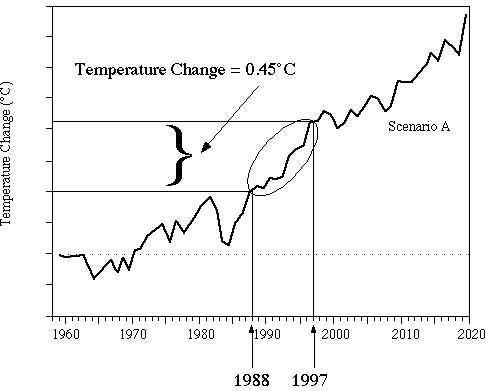
What The Science Says:
Although Hansen's projected global temperature increase has been higher than the actual global warming, this is because his climate model used a high climate sensitivity parameter. Had he used the currently accepted value of approximately 3°C warming for a doubling of atmospheric CO2, Hansen would have correctly projected the ensuing global warming.
Climate Myth: Hansen's 1988 prediction was wrong
'On June 23, 1988, NASA scientist James Hansen testified before the House of Representatives that there was a strong "cause and effect relationship" between observed temperatures and human emissions into the atmosphere. At that time, Hansen also produced a model of the future behavior of the globe’s temperature, which he had turned into a video movie that was heavily shopped in Congress. That model predicted that global temperature between 1988 and 1997 would rise by 0.45°C (Figure 1). Ground-based temperatures from the IPCC show a rise of 0.11°C, or more than four times less than Hansen predicted. The forecast made in 1988 was an astounding failure, and IPCC’s 1990 statement about the realistic nature of these projections was simply wrong.' (Pat Michaels)
Hansen et al. (1988) used a global climate model to simulate the impact of variations in atmospheric greenhouse gases and aerosols on the global climate. Unable to predict future human greenhouse gas emissions or model every single possibility, Hansen chose 3 scenarios to model. Scenario A assumed continued exponential greenhouse gas growth. Scenario B assumed a reduced linear rate of growth, and Scenario C assumed a rapid decline in greenhouse gas emissions around the year 2000.
The 'Hansen was wrong' myth originated from testimony by scientist Pat Michaels before US House of Representatives in which he claimed "Ground-based temperatures from the IPCC show a rise of 0.11°C, or more than four times less than Hansen predicted....The forecast made in 1988 was an astounding failure."
This is an astonishingly false statement to make, particularly before the US Congress. It was also reproduced in Michael Crichton's science fiction novel State of Fear, which featured a scientist claiming that Hansen's 1988 projections were "overestimated by 300 percent." Moreover, Michaels has continued to defend this indefensible distortion.
Compare the figure Michaels produced to make this claim (Figure 1) to the corresponding figure taken directly out of Hansen's 1988 study (Figure 2).

Figure 1: Pat Michaels' presentation of Hansen's projections before US Congress
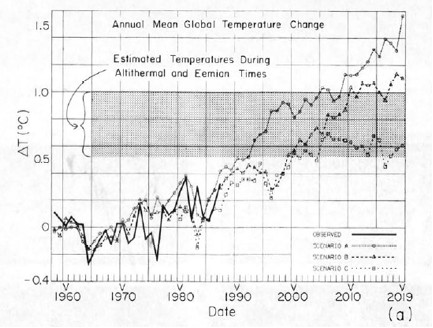
Figure 2: Projected global surface air temperature changes in Scenarios A, B, and C (Hansen 1988)
Notice that Michaels erased Hansen's Scenarios B and C despite the fact that as discussed above, Scenario A assumed continued exponential greenhouse gas growth, which did not occur. In other words, to support the claim that Hansen's projections were "an astounding failure," Michaels only showed the projection which was based on the emissions scenario which was furthest from reality.
Gavin Schmidt provides a comparison between all three scenarios and actual global surface temperature changes in Figure 3.
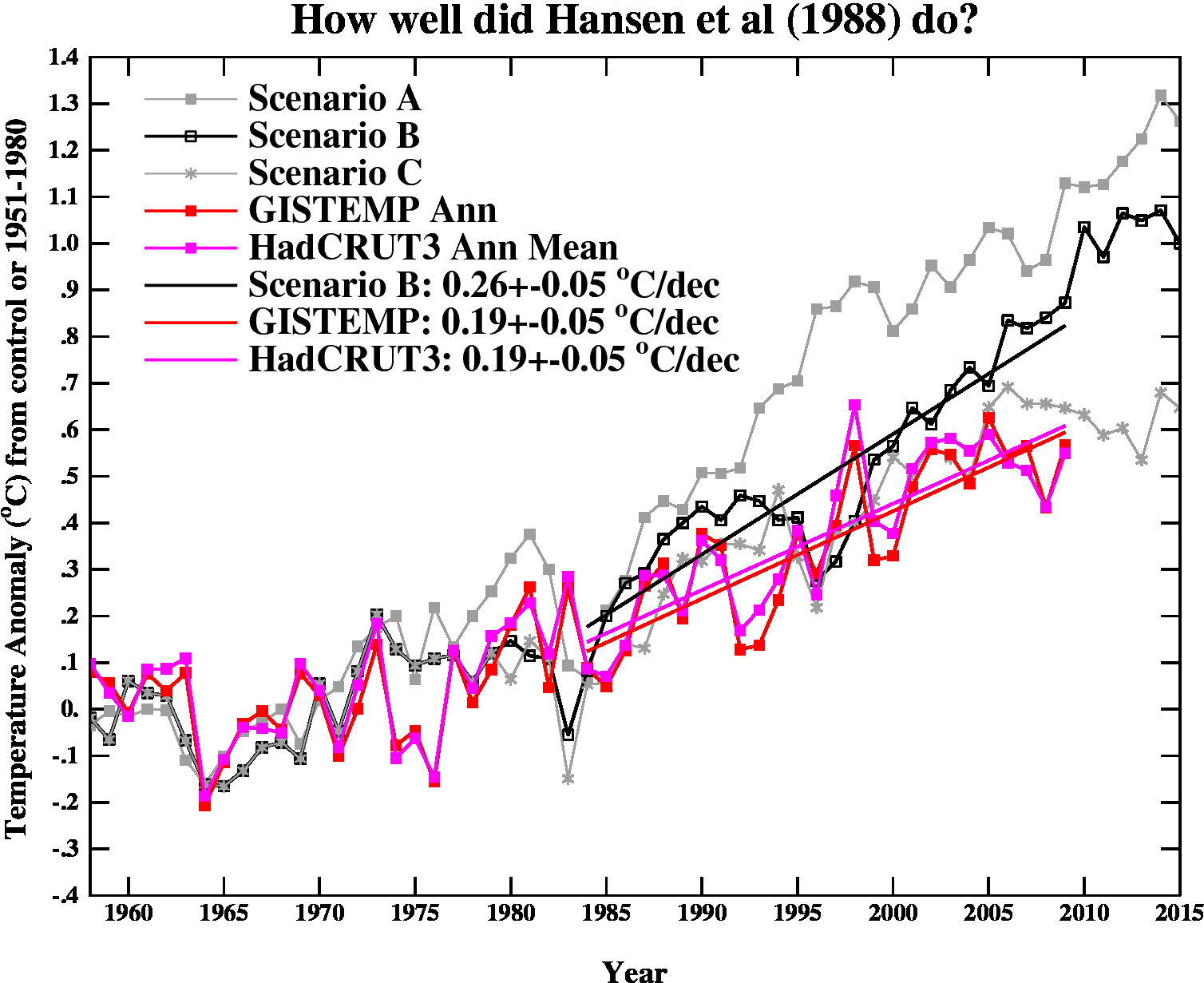
Figure 3: Hansen's projected vs. observed global temperature changes (Schmidt 2009)
As you can see, Hansen's projections showed slightly more warming than reality, but clearly they were neither off by a factor of 4, nor were they "an astounding failure" by any reasonably honest assessment. Yet a common reaction to Hansen's 1988 projections is "he overestimated the rate of warming, therefore Hansen was wrong."
In fact, when skeptical climate scientist John Christy blogged about Hansen's 1988 study, his entire conclusion was "The result suggests the old NASA GCM was considerably more sensitive to GHGs than is the real atmosphere." Christy didn't even bother to examine why the global climate model was too sensitive or what that tells us. If the model was too sensitive, then what was its climate sensitivity?
This is obviously an oversimplified conclusion, and it's important to examine why Hansen's projections didn't match up with the actual surface temperature change. That's what we'll do here.
So which scenario was the most accurate representation? Figures 4 below provides the answer. The radiative forcings for Hansen's three scenarios were estimated using the simplified radiative forcing expressions from the 2001 IPCC report, based on the projected greenhouse gas atmospheric concentrations for Hansen's scenarios. The actual radiative forcing estimates are taken from Skeie et al. (2011).
Hansen et al. only modeled the temperature response to greenhouse gas changes (and a few simulated volcanic eruptions). So in his simulations, the greenhouse gas (GHG)-only forcing and 'all forcings' are the same. In reality, they are not, with the main non-GHG forcing involving human aerosol emissions, whose effects remain one of the biggest uncertainties in climate science.
In our analysis here, we're interested in the changes since 1988, particularly through 1998. The radiative forcing changes since 1988 are shown in Figure 4.
Figure 4: Radiative forcing changes (1988 to 2010) for the three emissions scenarios in Hansen et al. 1988 (dark blue [A], red [B], and green [C]) vs. Skeie et al. (2011) GHG-only (light blue) and all anthropogenic forcings (purple).
Both the GHG-only and net anthropogenic forcing changes between 1988 and 1998 were very close to Hansen's Scenario C, consistent with Figure 1 above, primarily due to the CFC emissions reductions as a result of the Montreal Protocol.
As Figure 4 shows, Hasen's Scenario B is currently closest to the actual forcing (according to Skeie et al.), but running about 16% too high (since 1988). Figure 5 reproduces Hansen's Scenario B with a 16% reduction in the warming trend, to crudely correct for the discrepancy between it and the actual radiative forcing. This might be what Michaels' graphic would look like if he were to give an accurate version of his presentation today:
Figure 3: Observed temperature change (GISTEMP, blue) and with solar, volcanic and El Niño Southern Oscillation effects removed by Foster and Rahmstorf (green) vs. Hansen Scenario B trend adjusted downward 16% to reflect the observed changes in radiative forcings since 1988, using a 1986 to 1990 baseline.
In Figure 3 we've included both GISTEMP data, and GISTEMP with solar, volcanic, and El Niño Southern Oscillations removed by Foster and Rahmstorf (2011). The 1988 to 2010 trends are similar, 0.20°C per decade with the natural effects, 0.18°C per decade without. Scenario B has a 0.23°C per decade trend, but when removing a simulated volcanic eruption in 1996, the trend decreases to about 0.22°C per decade.
As the figure above shows, Hansen's 1988 model overpredicted the ensuing global warming. However, it only overpredicted the warming by approximately 15 to 25%, which is a far cry from the 300% overprediction claimed by Michaels in his 1998 congressional testimony.
Climate sensitivity describes how sensitive the global climate is to a change in the amount of energy reaching the Earth's surface and lower atmosphere (a.k.a. a radiative forcing). Hansen's climate model had a global mean surface air equilibrium sensitivity of 4.2°C warming for a doubling of atmospheric CO2 [2xCO2]. The relationship between a change in global surface temperature (dT), climate sensitivity (λ), and radiative forcing (dF), is
dT = λ*dF
Knowing that the actual radiative forcing was slightly lower than Hansen's Scenario B, and knowing the subsequent global surface temperature change, we can estimate what the actual climate sensitivity value would have to be for Hansen's climate model to accurately project the average temperature change.
What we find is that Hansen's results add to the long list of evidence that climate sensitivity is not low. As noted above, Hansen's model overpredicted the ensuing global warming thus far by approximately 15 to 25%. Thus if we estimate that the sensitivity of his model was 15 to 25% too high (which is an oversimplification, but will give us a reasonably accurate back-of-the-envelope estimate), this suggests the actual climate sensitivity is approximately 3.4 to 3.6°C for doubled CO2, which is close to the IPCC best estimate of 3°C.
The argument "Hansen's projections were too high" is thus not an argument against anthropogenic global warming or the accuracy of climate models, but rather an argument against climate sensitivity being as high as 4.2°C for 2xCO2, but it's also an argument for climate sensitivity being around 3°C for 2xCO2, which is consistent with the range of climate sensitivity values in the IPCC report.
Hansen's study also produced a map of the projected spatial distribution of the surface air temperature change in Scenario B for the 1980s, 1990s, and 2010s. Although the decade of the 2010s has just begun, we can compare recent global temperature maps to Hansen's maps to evaluate their accuracy.
Although the actual amount of warming (Figure 5) has been less than projected in Scenario B (Figure 4), this is due to the fact that as discussed above, we're not yet in the decade of the 2010s (which will almost certainly be warmer than the 2000s), and Hansen's climate model projected a higher rate of warming due to a high climate sensitivity. However, as you can see, Hansen's model correctly projected amplified warming in the Arctic, as well as hot spots in northern and southern Africa, west Antarctica, more pronounced warming over the land masses of the northern hemisphere, etc. The spatial distribution of the warming is very close to his projections.
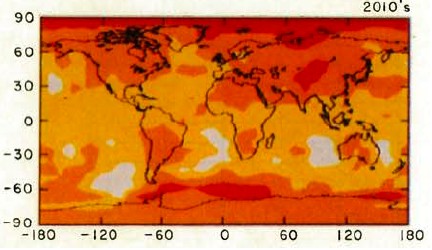

Figure 4: Scenario B decadal mean surface air temperature change map (Hansen 1988)
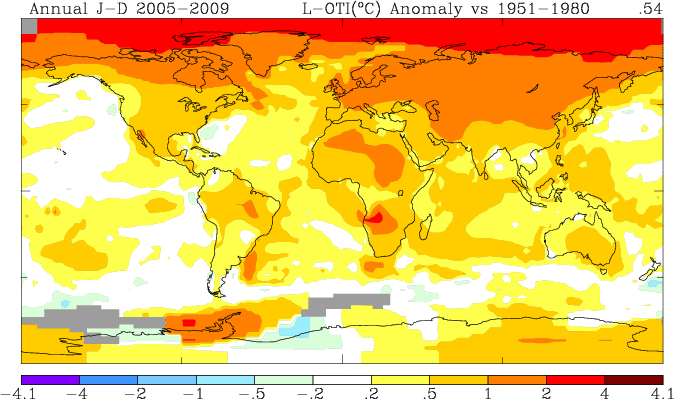
Figure 5: Global surface temperature anomaly in 2005-2009 as compared to 1951-1980 (NASA GISS)
Had Hansen used a climate model with a climate sensitivity of approximate 3°C for 2xCO2 (at least in the short-term, it's likely larger in the long-term due to slow-acting feedbacks), he would have projected the ensuing rate of global surface temperature change accurately. Not only that, but he projected the spatial distribution of the warming with a high level of accuracy. The take-home message should not be "Hansen was wrong therefore climate models and the anthropogenic global warming theory are wrong;" the correct conclusion is that Hansen's study is another piece of evidence that climate sensitivity is in the IPCC stated range of 2-4.5°C for 2xCO2.
 |
The Skeptical Science website by Skeptical Science is licensed under a Creative Commons Attribution 3.0 Unported License. |